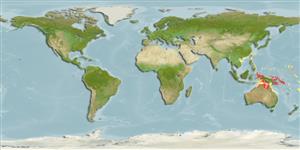>
Eupercaria/misc (Various families in series Eupercaria) >
Labridae (Wrasses) > Cheilininae
Etymology: Cirrhilabrus: Latin, cirrus = curl fringe + Greek, labros = furious (Ref. 45335); condei: Named in honor of Bruno Condé.
Eponymy: Dr Bruno Condé (1920–2004) was a French zoologist and speleologist, whose doctorate in natural science was awarded by the Faculty of Sciences, University of Nancy (1952), where he had started work as a botany collector (1943). [...] (Ref. 128868), visit book page.
More on authors: Allen & Randall.
Environment: milieu / climate zone / Tiefenbereich / distribution range
Ökologie
seewasser riff-verbunden; standorttreu; tiefenbereich 5 - 70 m (Ref. 31120). Tropical
Western Pacific: Papua New Guinea.
Size / Gewicht / Alter
Geschlechtsreife: Lm ? range ? - ? cm
Max length : 8.0 cm TL Männchen/unbestimmt; (Ref. 31120)
Rückenflossenstacheln (insgesamt) : 11; Rückenflossenweichstrahlen (insgesamt) : 9; Afterflossenstacheln: 3; Afterflossenweichstrahlen: 9.
Body shape (shape guide): fusiform / normal.
Occurs inshore (Ref. 75154). Relatively common on sloping rubble bottoms (Ref. 31120).
Life cycle and mating behavior
Geschlechtsreife | Fortpflanzung | Ablaichen | Eier | Fecundity | Larven
Distinct pairing during breeding (Ref. 205).
Allen, G.R. and J.R. Randall, 1996. Three new species of wrasses (Labridae: Cirrhilabrus) from Papua New Guinea and the Solomon Islands. Rev. Fr. Aquariol. 23(3-4):101-112. (Ref. 31120)
IUCN Rote Liste Status (Ref. 130435: Version 2025-1)
Bedrohung für Menschen
Harmless
Nutzung durch Menschen
Tools
Zusatzinformationen
Download XML
Internet Quellen
Estimates based on models
Preferred temperature (Ref.
123201): 26.9 - 28.8, mean 28 °C (based on 232 cells).
Phylogenetic diversity index (Ref.
82804): PD
50 = 0.5000 [Uniqueness, from 0.5 = low to 2.0 = high].
Bayesian length-weight: a=0.01585 (0.00700 - 0.03587), b=2.95 (2.76 - 3.14), in cm total length, based on LWR estimates for this (Sub)family-body shape (Ref.
93245).
Trophic level (Ref.
69278): 3.3 ±0.4 se; based on size and trophs of closest relatives
Widerstandsfähigkeit (Ref.
120179): hoch, Verdopplung der Population dauert weniger als 15 Monate. (Preliminary K or Fecundity.).
Fishing Vulnerability (Ref.
59153): Low vulnerability (10 of 100).
🛈
